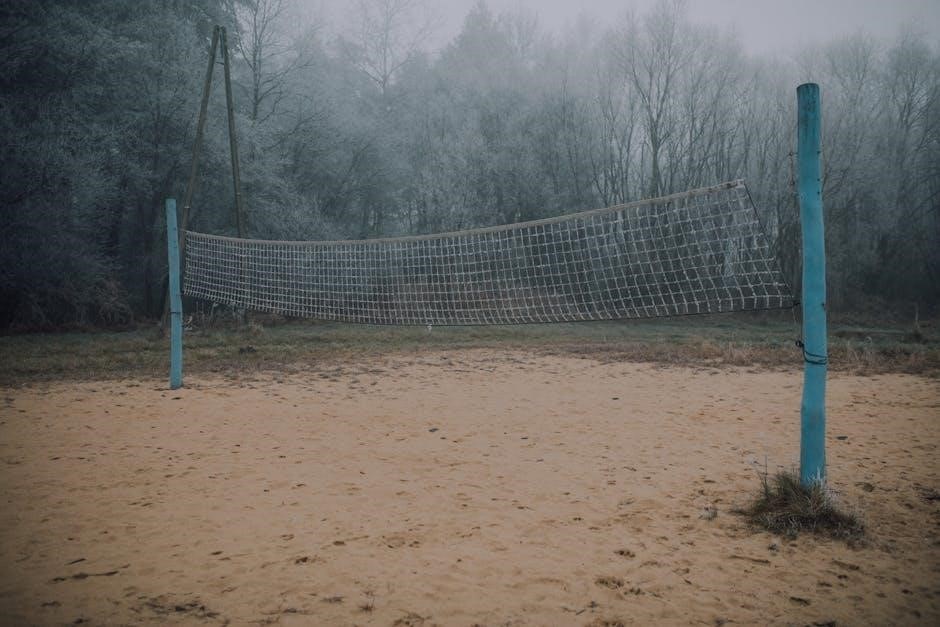
Volleyball is a dynamic sport governed by standardized rules to ensure fair play and consistency globally. Understanding these rules is essential for players‚ referees‚ and fans to fully engage with the game.
1.1 Overview of Volleyball as a Sport
Volleyball is a popular team sport played globally‚ requiring skill‚ strategy‚ and physical fitness. Governed by the FIVB‚ it involves two teams of six players each‚ competing to hit the ball over the net. The sport emphasizes teamwork‚ quick reflexes‚ and precise movements. Its simplicity and exciting nature make it accessible to players of all levels‚ from recreational to professional leagues. Volleyball fosters camaraderie and competition‚ making it a beloved sport worldwide.
1.2 Importance of Understanding the Rules
Understanding volleyball rules is crucial for ensuring fair play‚ safety‚ and enjoyment for all participants. Clear knowledge of regulations enables players‚ coaches‚ and referees to perform their roles effectively. It promotes sportsmanship‚ reduces conflicts‚ and maintains the integrity of the game. Familiarity with rules also enhances strategic decision-making and teamwork‚ allowing players to compete at their best. Staying updated on rule changes‚ as outlined in official FIVB publications‚ ensures consistency across all levels of play.
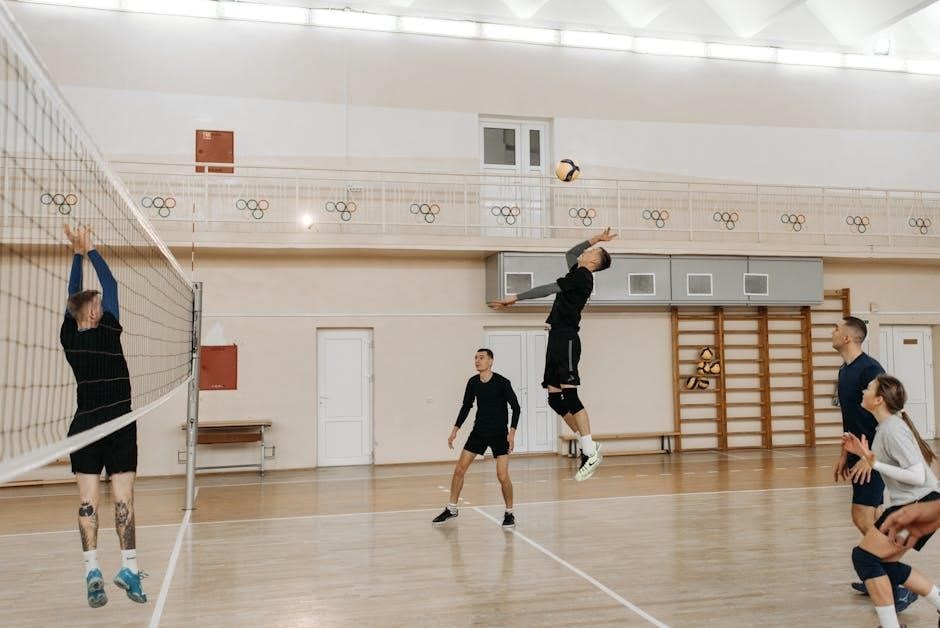
FIVB and Official Volleyball Rules
The FIVB governs global volleyball‚ ensuring standardized rules for fair play. Official rulebooks‚ like the 2023-2024 PDF‚ provide consistent guidelines for all levels of competition internationally.
2.1 Role of FIVB in Governing Volleyball
The FIVB‚ or Fédération Internationale de Volleyball‚ plays a crucial role in governing volleyball worldwide. It establishes and updates official rules‚ ensuring consistency across all levels of play. The FIVB works closely with national federations and organizations to promote the sport and maintain fair competition. By developing rulebooks and organizing training programs‚ the FIVB ensures that volleyball remains a unified and progressive sport globally.
2.2 Official Rulebooks and Updates
Official volleyball rulebooks are published by the FIVB to provide clear guidelines for players‚ referees‚ and coaches. These rulebooks are updated regularly‚ with the latest edition covering the 2023-2024 season. Updates include changes to scoring systems‚ player roles‚ and equipment standards. The rulebooks are available in PDF format on the FIVB website‚ ensuring accessibility for all stakeholders. They serve as the definitive resource for understanding the game’s regulations and maintaining uniformity across competitions.
2.3 Recent Changes to the Rules (2023-2024)
Recent rule changes for the 2023-2024 season include the abolition of mid-rally video challenges‚ simplifying dispute resolution. Modifications to positional faults and net violations have been introduced to enhance fair play. Additionally‚ the role of the libero has been clarified‚ and serving rules now allow the ball to graze the net. These updates aim to improve game flow‚ increase player safety‚ and ensure consistent enforcement of regulations across all competitions.
2.4 Importance of the FIVB Rulebook
The FIVB Rulebook is the authoritative guide for volleyball‚ ensuring uniformity and fairness in international competitions. It outlines game setup‚ player conduct‚ and referee responsibilities‚ providing clarity for participants. Regular updates reflect evolving standards‚ maintaining the sport’s integrity. By adhering to the rulebook‚ players and officials uphold the spirit of fair play‚ fostering a competitive and respectful environment globally.
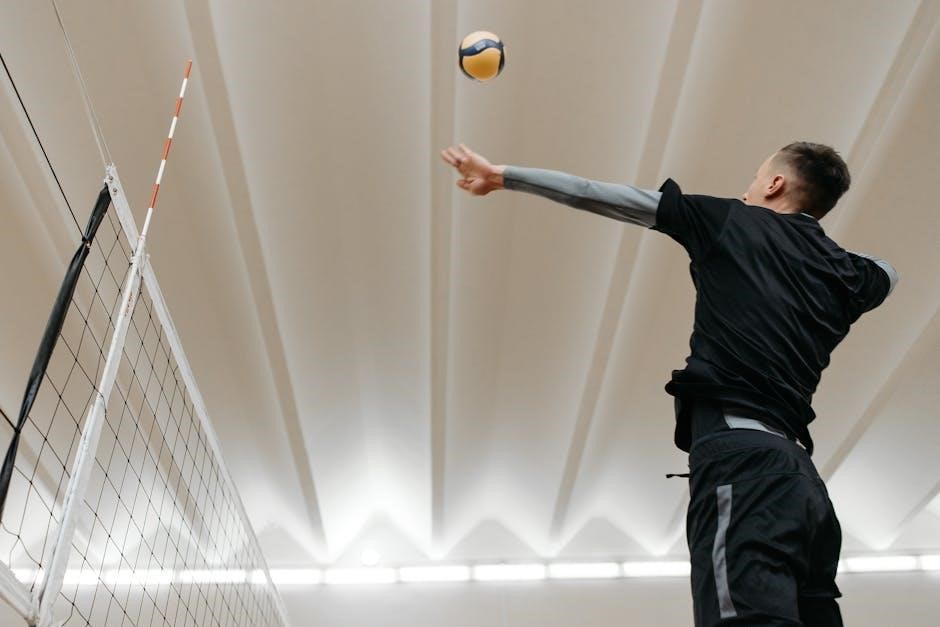
Game Setup and Equipment
A volleyball court measures 18m long and 9m wide‚ divided by a net. The ball must meet FIVB standards for size‚ weight‚ and material to ensure fair play.
3.1 Number of Players and Team Composition
A volleyball team consists of 12 players‚ with one designated as the Libero‚ who wears a contrasting jersey. Teams may have up to 14 players for FIVB and World Competitions‚ with two Liberos required if the squad exceeds 12. The team captain‚ indicated on the score sheet‚ leads the squad and communicates with referees. Substitutions are limited‚ and only players listed on the score sheet are allowed to participate. This structure ensures organized and fair competition‚ adhering to FIVB regulations.
3.2 Volleyball Court Dimensions and Setup
A volleyball court measures 18 meters in length and 9 meters in width‚ divided into two equal halves by a center line. The net stands at the center‚ with a height of 2.43 meters for men’s competitions and 2.24 meters for women’s. Attack lines are marked 3 meters from the net on both sides‚ defining the front zone. The court setup ensures standardized play‚ adhering to FIVB regulations for fair and competitive matches at all levels.
3.3 Ball Standards and Equipment
The official volleyball ball must meet FIVB standards‚ ensuring consistency in size‚ weight‚ and performance. It measures 65-67 cm in circumference for men and 63-65 cm for women‚ weighing 260-300 grams. Made of leather or synthetic materials‚ the ball is designed for optimal grip and durability. The inflation pressure is 0.30-0.325 kg/cm²‚ ensuring proper bounce. Teams must use balls approved by FIVB for competitions‚ guaranteeing visibility and fairness in play. Proper equipment is essential for safe and regulated gameplay.
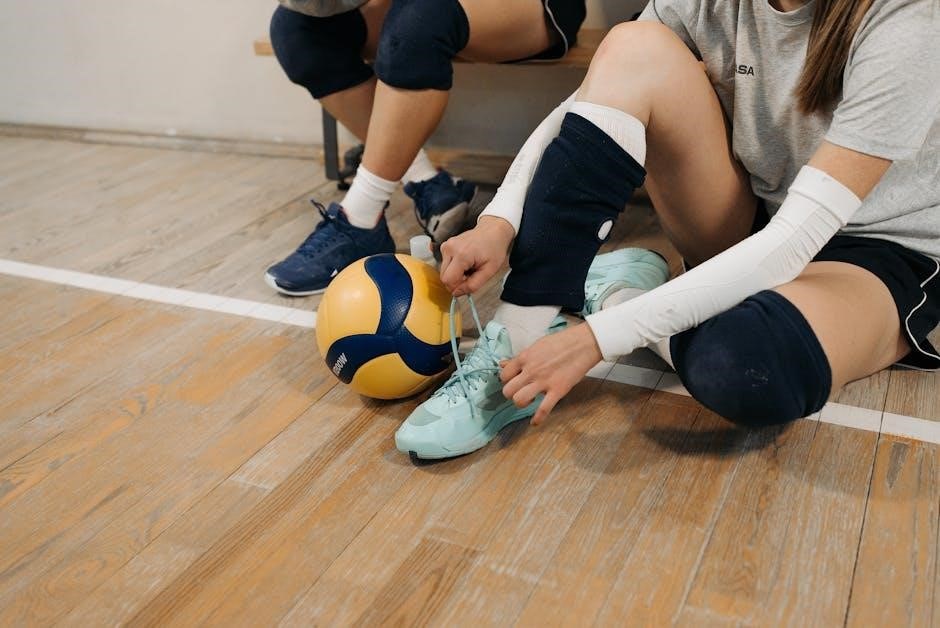
Gameplay Rules
Volleyball gameplay rules ensure fair play‚ outlining scoring systems‚ game length‚ and legal contacts. Players must serve‚ hit‚ and move the ball within defined regulations to maintain game integrity.
4.1 Scoring System and Game Length
Volleyball matches are played best two of three or best three of five sets. Each set is won by the first team to reach 25 points with a two-point lead. If the score reaches 24-24‚ play continues until one team gains a two-point advantage. The match duration varies‚ but sets typically last around 20-30 minutes. Scoring is straightforward‚ with points awarded for successful plays or opponents’ errors.
4.2 Serving Rules and Regulations
A serve is the initial play to start a rally. The server must toss the ball and strike it with the hand within the service zone. The ball must clear the net and land in the opponent’s court. A serve can be underhand or overhand but cannot be caught or held. The ball may graze the net but must still land in the opponent’s court for a valid serve. Subsequent serves are determined by the previous point’s outcome.
4.3 Legal Contacts and Faults
A player can contact the ball up to three times per rally. Illegal contacts include lifting‚ holding‚ or throwing the ball. Faults occur if a player touches the net or reaches over it. Blocking and attacking at the net must follow specific rules to avoid penalties. A player cannot make contact with the ball using an open hand or fist for setting. Any violation of these rules results in a point for the opposing team. Proper technique is essential to avoid penalties.

Violations and Penalties
Violations in volleyball include illegal contacts‚ such as lifting or holding the ball‚ and unsportsmanlike conduct. Penalties range from loss of point to disqualification. Referees enforce these rules to ensure fair play and sportsmanship.
5.1 Common Violations in Volleyball
Common violations include illegal contacts like lifting‚ holding‚ or double-touching the ball. Players may also commit positional faults or cross the center line. Unsportsmanlike conduct‚ such as arguing with referees‚ is penalized. Repeated violations can lead to loss of points or disqualification. Referees closely monitor these actions to maintain fair play and ensure adherence to official rules‚ promoting a competitive yet respectful environment for all participants.
5.2 Penalty Procedures and Consequences
Penalties are enforced to uphold fair play and rule adherence. Common consequences include loss of serve‚ points‚ or right to attack. Repeated violations may lead to player disqualification. Referees signal penalties clearly‚ ensuring transparency. Teams are held accountable through these measures‚ maintaining the integrity of the game. Understanding these procedures is crucial for players and officials to manage gameplay effectively and respectfully.

Specialized Roles in Volleyball
Volleyball teams have specialized roles like the Libero‚ who excels in defense‚ and the Team Captain‚ responsible for communication and leadership on the court. These roles ensure effective teamwork and strategic gameplay.
6.1 The Role of the Libero
The Libero is a specialized defensive player restricted to the back row. Their primary roles include receiving serves‚ digging attacks‚ and coordinating team defense. They cannot block‚ attack‚ or serve and must wear a different jersey for identification. The Libero’s strategic substitutions and ball-handling skills are crucial for team success‚ emphasizing their importance in modern volleyball strategies and gameplay dynamics. Their role enhances team performance by focusing solely on defensive excellence and tactical play.
6.2 Team Captain and Their Responsibilities
The team captain plays a pivotal role in maintaining order and communication within the team. They are responsible for leading the team‚ ensuring adherence to rules‚ and representing the team during matches. The captain is indicated on the score sheet and must communicate with referees to clarify rules or disputes. They also oversee player conduct‚ fostering sportsmanship and fair play. The captain’s leadership is crucial for team cohesion and strategic decision-making during the game‚ ensuring smooth interactions with officials and opponents alike.
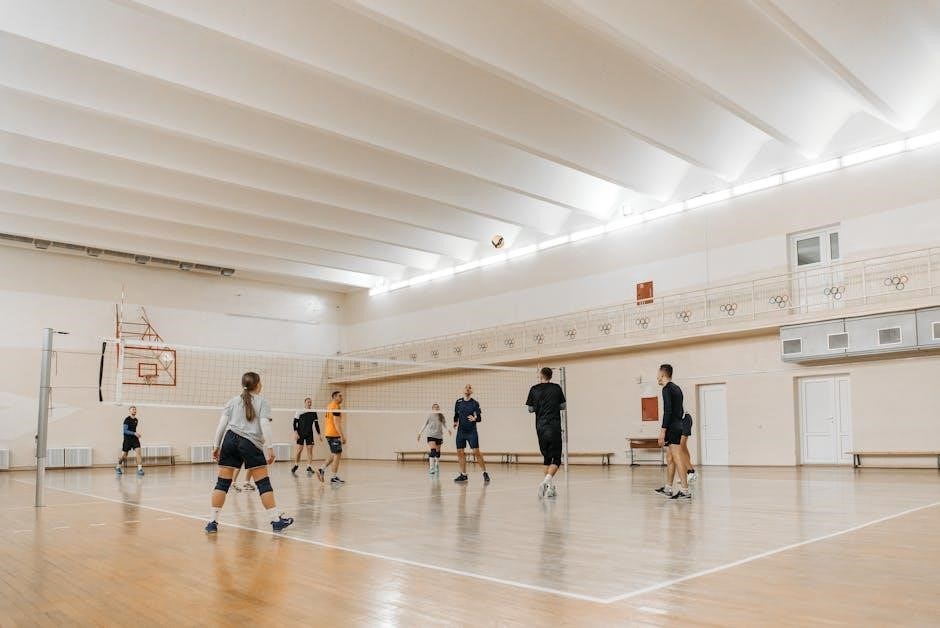
Referee and Officials
Referees and officials are crucial for enforcing rules‚ maintaining fair play‚ and ensuring smooth gameplay. Their decisions are final‚ and they oversee all aspects of the match.
7.1 Responsibilities of the Referee
The referee is the primary authority on the court‚ responsible for enforcing all volleyball rules and ensuring fair play. Their duties include supervising the game‚ making decisions on faults‚ and managing protests. Referees also oversee pre-match inspections‚ verify equipment compliance‚ and handle player conduct. They work closely with other officials to maintain order and ensure accurate scoring. The referee’s decisions are final‚ and they play a crucial role in upholding the integrity of the game.
7.2 Role of the Scorers and Line Judges
Scorers and line judges are vital for accurate game management. Scorers record points‚ fouls‚ and substitutions‚ ensuring the score sheet is precise. Line judges monitor the court boundaries‚ signaling faults like touches or out-of-bounds plays. They work closely with the referee to maintain game integrity‚ providing clear signals for decisions. Their roles are essential for fair play and smooth gameplay‚ supporting the referee in enforcing rules effectively during the match.

Recent Rule Changes
Recent updates to volleyball rules include the abolition of mid-rally video challenges and adjustments to serve rules‚ aiming to enhance game flow and fairness for all players.
8.1 Key Modifications in the 2023-2024 Rules
The 2023-2024 volleyball rules introduced significant changes‚ including the elimination of mid-rally video challenges and revised serving regulations. These modifications aim to streamline gameplay‚ reduce interruptions‚ and maintain fair competition. Additionally‚ updates to player conduct rules emphasize sportsmanship and respect‚ aligning with FIVB’s commitment to enhancing the sport’s integrity and global appeal. These changes reflect ongoing efforts to modernize volleyball while preserving its core traditions.
8.2 Impact of Technology on Rule Enforcement
Technology has significantly influenced volleyball rule enforcement‚ enhancing accuracy and consistency. Automated systems now track court dimensions‚ while video challenge systems allow referees to review contested plays‚ reducing human error. Additionally‚ electronic scoring systems ensure precise match tracking. These advancements‚ approved by FIVB‚ contribute to fairer gameplay and smoother tournaments‚ demonstrating how technology supports the sport’s evolution while maintaining its integrity and appeal.

Player Conduct and Sportsmanship
Player conduct and sportsmanship are essential‚ emphasizing respect for referees‚ teammates‚ opponents‚ and spectators. Fair play must be upheld‚ avoiding actions that delay the game or provide unfair advantages‚ ensuring a positive and respectful environment for all participants.
9.1 Expectations for Player Behavior
Players are expected to exhibit respect and sportsmanship at all times‚ adhering to the principles of fair play. This includes respectful behavior toward referees‚ teammates‚ opponents‚ and spectators. Participants must avoid actions that delay the game or gain unfair advantages. Maintaining a positive and respectful attitude ensures a constructive environment for competition. Understanding and abiding by the official rules fosters mutual respect and ensures the game’s integrity‚ promoting enjoyable and fair play for everyone involved.
9.2 Prohibited Actions and Penalties
Prohibited actions include delaying tactics‚ unsportsmanlike behavior‚ and net violations. Penalties for such offenses include warnings‚ yellow or red cards‚ and disqualification; Repeated violations can lead to more severe penalties‚ ensuring fair play. Referees enforce these penalties to maintain game integrity and uphold sportsmanship. Understanding these penalties is crucial for players and teams to compete fairly. Adherence ensures a positive and respectful environment for all participants. These guidelines are outlined in the FIVB’s official rulebook.

Resources for Further Reading
Official FIVB publications‚ downloadable PDF guides‚ and rulebooks provide comprehensive insights into volleyball rules. These resources are essential for players‚ referees‚ and enthusiasts seeking detailed information.
10.1 Official FIVB Publications
The FIVB provides official rulebooks in PDF format‚ ensuring accessibility for players‚ referees‚ and enthusiasts. These publications detail game rules‚ updates‚ and interpretations‚ serving as the definitive guide for understanding volleyball regulations worldwide. Regularly updated‚ they reflect the latest changes in the sport‚ making them indispensable resources for staying informed and compliant with international standards. Downloadable from the FIVB website‚ these documents are essential for anyone involved in volleyball.
10.2 Downloadable PDF Guides
Downloadable PDF guides from FIVB offer comprehensive resources for volleyball rules‚ including detailed rulebooks and case studies. These guides are updated annually to reflect rule changes and provide clarity on game regulations. Available on the FIVB website‚ they cater to players‚ coaches‚ and referees‚ ensuring everyone has access to the latest information. PDF guides are convenient for offline use‚ making them a valuable tool for training sessions‚ competitions‚ and personal study‚ ensuring consistency in understanding and application of volleyball rules worldwide.
Understanding volleyball rules ensures fair play and enjoyment for all. Staying updated with FIVB guidelines and downloadable PDF resources is crucial for players‚ referees‚ and fans alike.
11.1 Summary of Key Rules
Volleyball rules‚ governed by FIVB‚ ensure fair play and consistency. Key elements include team composition‚ scoring systems‚ legal contacts‚ and prohibited actions. Recent updates‚ like the abolition of mid-rally video challenges‚ reflect modern gameplay. Understanding these rules enhances player performance‚ referees’ accuracy‚ and spectator enjoyment. Staying informed through official PDF guides and updates is essential for adapting to rule changes and maintaining sportsmanship in all competitions.
11.2 Importance of Staying Updated
Staying updated on volleyball rules is crucial for players‚ referees‚ and fans to ensure fair play and adapt to gameplay evolution. FIVB regularly updates rules‚ such as the abolition of mid-rally video challenges‚ to enhance competition. These changes‚ detailed in official PDF guides‚ reflect technological advancements and gameplay improvements. Adhering to updated rules ensures consistency‚ sportsmanship‚ and the integrity of the sport‚ making it essential for everyone involved to stay informed and aligned with the latest regulations.